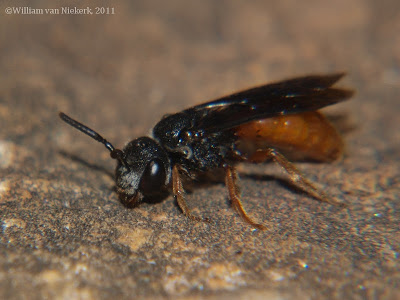A not-very-good photo for you today:
.JPG) |
| Photographed in Chongwe, Lusaka, Zambia, in March 2013. It's not a good enough picture to warrant telling you what with. |
No. It's more along the lines of Dolichotachina caudata, Megistocera filipes and
Synagris proserpina, although not quite so dramatic. A good picture it may not be, but it is the only picture I can locate on the web of a living member of either species that this could be*. And I'm still not dismissing that it may not really be
Metadon inermis
(Loew, 1858)
because that would be foolish.
One interesting aside, though, comes in comparison. Behold:
This is a bee, Sphecodes, displaying a colour form common in Central African stinging insects.
Look again at our (harmless) fly:
The size is different, closer in the fly to the similarly coloured Megachile bees from the same area, but the similarities between these two individuals was too much for me to pass up showing you Sphecodes.
Anyhow, onwards with the taxonomy:
Microdontinae
Syrphidae
Syrphoidea
Aschiza
Muscomorpha
Brachycera
Diptera
See also Megistocera filipes
Antliophora
See also Panorpa germanica
Panorpida
See also Acada biseriata, Anthocharis cardamines, Laelia robusta, Zebronia phenice and Crambus pascuella
Endopterygota
See also Andrena nigroaenea, Synagris proserpina, Vespula germanica, Astata tropicalis, Hagenomyia tristis, Demetrias atricapillus, Anthia fornasiini, Melolontha melolontha, Malachius bipustulatus, Otiorhynchus atroapterus and Cheilomenes lunata
Eumetabola
Neoptera
See also Cyathosternum prehensile, Lobosceliana loboscelis, Stictogryllacris punctata, Sibylla and Humbe tenuicornis
Manopterygota
Pterygota
Dicondylia
Insecta
Hexapoda
Arthropoda
See also Ligia oceanica, Dicranopalpus ramosus, Enoplognatha ovata, Argiope bruennichi and Hyllus argyrotoxus
Ecdysozoa
Protostomia
Nephrozoa
See also Burhinus vermiculatus, Sterna hirundo, Ardea goliath, Chalcophaps indica, Thelotornis capensis, Trachylepis varia, Lygodactylus capensis, Hipposideros vittatus, Rana temporaria, Chiromantis xerampelina, Synchiropus splendidus and Troglodytes troglodytes
Bilateralia
Eumetazoa
Animalia
Eukaryota
And that's all, folks!
* Reemer's article revising the oversized genus Microdon does also contain images of M. inermis pinned specimens, among other things.
For anyone trying to identify members of this subfamily, Reemer's key, mentioned above, is not only the most up-to-date resource I am aware of, but also available free. Happy times.


No comments:
Post a Comment